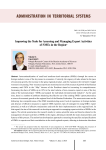Administration in territorial systems. Рубрика в журнале - Economic and Social Changes: Facts, Trends, Forecast

Improving the tools for assessing and managing export activities of SMEs in the region
Статья научная
Internationalization of small and medium-sized enterprises (SMEs) through the access to foreign markets is one of the key issues in economics. Currently, the urgency of tasks related to the pace of economic growth, the increase in the gross regional product, and the expansion the territories’ budget revenues is increasing. Non-resource exports are mentioned as one of the sources of growth of the Russian economy until 2024 in the “May” decrees of the President aimed at increasing its competitiveness. Increasing the share of SMEs up to 10% in the total volume of non-resource exports is one of the key tasks of the national project “SMEs and support for individual entrepreneurial initiative”. At the same time, there is a number of problems hindering the effective use of the existing SMEs’ export potential as a source of economic growth at the regional level of the Russian Federation. The most acute ones are the following: low competitiveness of the SME manufacturing sector; lack of experience in foreign markets and absence of effective measures to support SME exporters; lack of strategies for using SMEs’ export potential, as well as of effective mechanisms and tools for their implementation at the regional level. In this regard, the aim of the research is to develop an approach to managing export activities of SMEs in the region. The article systematizes the research results in various scientific areas and theories related to the management of export activities of SMEs in the region, allowing to identify the main characteristics and features of this process. The author has developed an approach to assessing the specifics and specifications of SMEs in exports and their contribution to the total regional exports, allowing to determine directions for further support areas development. The analysis of the existing export promotion system is carried out. The directions, regulations and tools for the Federal and regional levels forming a unified system of SMEs management and support in terms of export activities are proposed.
Бесплатно

Статья научная
Small business plays a special role in socio-economic development of territorial entities. Implementing the resource potential of a local area is the main and typical feature in the functioning of its subjects. However, issues related to the management of the sector, remain insufficiently developed in the framework of individual municipalities. On this basis, the aim of the present research is to develop an organizational and economic mechanism for managing small business, which would ensure the implementation of policy measures to enhance the functioning of regional small business at the municipal level. In order to achieve this goal, we set out the tasks to develop recommendations to promote the work of small organizations with the help of program activities and organizational and economic mechanism to ensure their implementation, as well as recommendations for the calculation of their economic effects. Methodological approaches to the research are based on general scientific methods (comparison, generalization, analysis, synthesis) and statistical methods (correlation, regression analysis)...
Бесплатно

Статья научная
In Russia, the development of strategic socio-economic development programs is regulated by Federal Law 172-FZ of June 28, 2014, according to which long-term development ideas should be displayed on the schemes of territorial development. The main problem in the development of territorial planning schemes concerns the accuracy of forecasting the number of population living in municipal entities in relation to the time horizon determined by strategic plans. Practical application of the correlation between the population and the number of jobs created or saved can translate the amount of financial resources provided for the implementation of long-term development programs into quantitative indicators necessary to calculate the number and capacity of social and transport infrastructure facilities. The goal of our research is to prove the existence of statistical dependence of the number of population on the number of jobs in the regional and municipal economy. To achieve the goal we determined the statistical correlation between the population of Russia's regions and the number of jobs in the economy (employed population)...
Бесплатно

Статья научная
At present, the issues related to economic growth rate, increase in gross regional product, and expansion of budget revenues of territories are coming to the fore. Export is an important resource for regional economic development. However, despite the fact that exports play a major role in the economy, Russia’s share in foreign economic activity is insignificant (1.8%) and tends to decrease. In absolute values, Russia’s export is ten times lower than that of China and five times lower than that of the U.S. Under the circumstances, it is crucial to determine the priorities of export activity. In this regard, the goal of our study is to determine the priorities and directions in boosting export activity as a necessary aspect of economic growth of territories and development of the national economy. In accordance with the goal of the paper, we consider the evolution of the views on the role of export activity in economic growth and develop a scientifically substantiated methodological approach to assessing the real share of non-resource-based export of Russia’s regions in the total volume of goods shipped abroad...
Бесплатно

Public administration issues in the development of the non-profit sector at the regional level
Статья научная
At the current stage of socio-economic development of the country the non-profit sector becomes a vital actor in the management system and the object of governance with its own unique features. The goal of this article is to present scientific propositions based on intersectoral social partnership for improving governance of non-profit organizations in the Russian regions. To achieve this goal, we used methods of systemic, comparative, statistical and sociological analysis. Works of domestic and foreign authors on the problems of engagement between authorities and the non-profit sector were analyzed. The conclusion that the term “intersectoral social partnership” is more appropriate for the conditions of the Russian regions was made. The Russian legal basis for governance of the non-profit sector at the federal and the regional levels was studied. It was identified that the conditions to attract new service providers to the social sphere were created - these providers are called “socially oriented non-profit organizations” (hereinafter - SONPOs). But it was identified that the legal basis, which opens new opportunities for SONPOs to be involved in social programs of the government, was not supported by proactive measures to strengthen the economy and human capacity of the considered organizations. This article proves that a region is the central element in the implementation of governmental policy in the sphere of regulation and support of the non-profit sector: discussed cooperation is implemented at the regional level. The concluding part of the article names structural organizational-economic and legal measures to improve the cooperation between regional, municipal authorities and the non-profit sector within intersectoral social partnership. The results of this research might be used to develop well-balanced state regional policy and programming documents as well as to plan strategic and operational events for the advancement of the non-profit sector in the entities of the Russian Federation.
Бесплатно

Territorial planning and Zipf's law
Статья научная
Territorial planning is an integral part of strategic planning in accordance with the current legislation of the Russian Federation. When development strategies are elaborated, the assessment of the socio-economic situation in the region should be based on the results obtained in the course of studying the current situation in a constituent entity of the Russian Federation in comparison with its border territorial entities, as well as in comparison with indicators in the macroregion (federal district). SWOT analysis is the most common technology for assessing the situation in a region. Due to various reasons the use of this method does not provide high accuracy of the result. The use of the Zipf distribution (inversely proportional dependence) as a reference provides an opportunity for a more accurate quantitative analysis of the dynamics of indicators used to assess the socio-economic situation in territorial entities. The goal of the paper is to determine current external conditions, trends and imbalances in the socio-economic situation in a region with the use of Zipf's law. In contrast to the traditional use of the law in the study of demographic indicators, our paper aims to consider the dynamics of changes in gross regional product and in the number of jobs. The results indicate that the distribution of the value added and the distribution of number of jobs tend to an inversely proportional function. The discussion of the results is presented in the form of a discussion on the impact of socio-economic situation on the formation of long-term development plans; the discussion takes into account the positions of constituent entities of the Russian Federation on the Zipf curve. In addition, we substantiate the possibility and necessity of using the gross regional product indicator in the conditions of the Russian Federation. Our conclusions show the advantage of using distributions to study the existing external environment in a constituent entity of the Russian Federation. Practical application of Zipf's law helps define the starting conditions and forecast the consequences of implementation of socio-economic development strategies more accurately and to substantiate quantitative indicators for long-term plans.
Бесплатно

